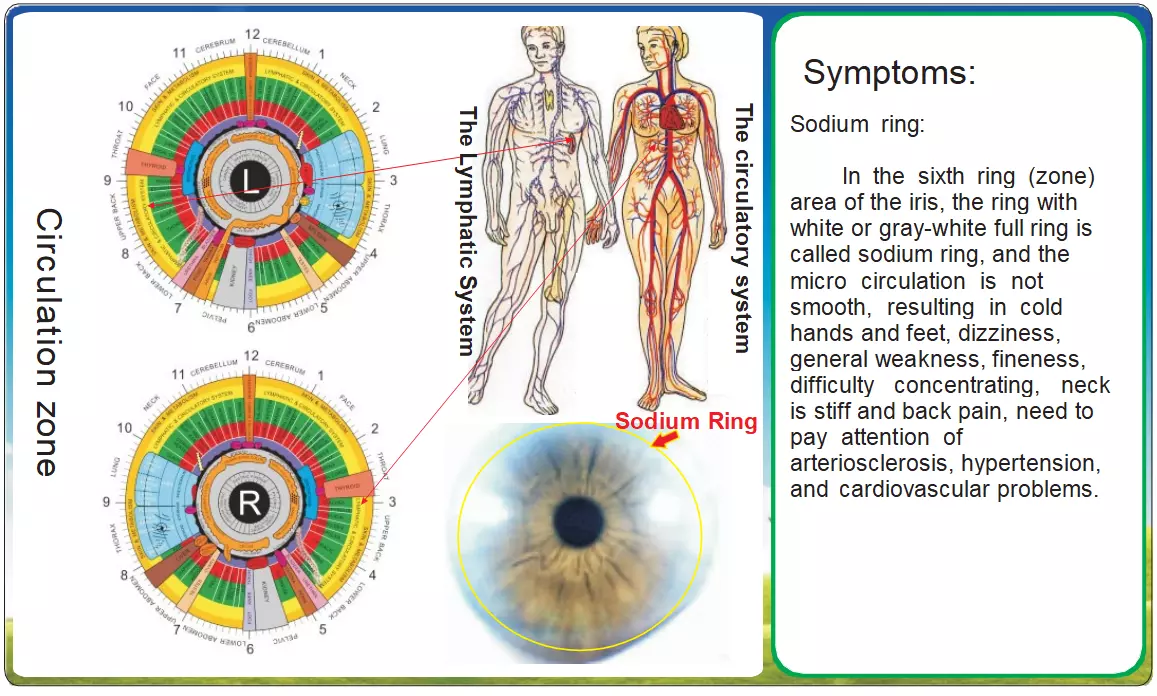Iridology-Sodium Rings, Lymphatic Dysfunction, and Systemic Implications
8.3 Iridology- Circulatory System: Zones, Lymphatics, and Clinical Correlations
8.3 Iridology-The circulatory system, a cornerstone of human physiology, encompasses both vascular and lymphatic networks, each playing distinct yet interconnected roles in maintaining homeostasis. Within iridology, specific iris zones reflect systemic circulation status, with the sixth zone (or “anneau”) serving as a critical indicator of microcirculatory efficiency.

Circulation Zones in the Iris
The iris is anatomically divided into concentric zones, each correlating with different bodily systems. The sixth zone, often termed the “sodium ring,” manifests as a complete or partial ring of white or gray-white discoloration. This hallmark sign suggests Microcirculation altérée, which may stem from vascular stiffness, oxidative stress, or metabolic imbalances.
The Lymphatic System’s Role
While the circulatory system delivers oxygen and nutrients, the lymphatic system manages immune surveillance and fluid balance. Dysfunction here may compound circulatory issues, exacerbating symptoms like œdème localisé ou inflammation chronique. Notably, lymphatic stagnation often parallels venous insufficiency, further stressing the need for integrated diagnostics.
The Circulatory System: Clinical Symptoms and Risks
A sodium ring in the iris signals systemic microcirculatory disturbances, frequently presenting with:
- Cold extremities en raison d'une mauvaise perfusion périphérique.
- Étourdissements et fatigue from reduced cerebral blood flow.
- Raideur du cou et maux de dos, linked to vertebral artery insufficiency or muscular hypoxia. These symptoms warrant vigilance for artériosclérose, hypertension et maladies cardiovasculaires, as chronic microcirculatory deficits may precede overt pathology.
Analyse comparative des systèmes
| Aspect | Système circulatoire | Système lymphatique |
|---|
| Fonction primaire | Oxygène / livraison des nutriments via les vaisseaux sanguins | Support immunitaire, drainage fluide |
| Indicateur de l'iris | Anneau de sodium (6e zone) | Rarely visualized directly in iris |
| Symptômes clés | Cold hands/feet, dizziness, hypertension | Gonflement, infections récurrentes |
| Risques pathologiques | Athérosclérose, accident vasculaire cérébral | Lymphœdème, inflammation chronique |
Expanded Insights
- Microcirculation and Organ Health: The sodium ring’s presence often correlates with endothelial dysfunction, a precursor to systemic vascular disease. Studies suggest interventions like antioxidant supplementation (e.g., flavonoids) may improve capillary integrity.
- Lymph-Circulatory Crosstalk: Poor lymphatic drainage can exacerbate venous congestion, creating a vicious cycle. Manual therapies (e.g., lymphatic massage) and hydration are empirically supported adjuncts.
- Diagnostic Integration: While iridologie offers preliminary clues, confirmatory tests like Doppler ultrasound ou capillaroscopy are essential for definitive diagnosis.
Conclusion
The iris’s sixth zone serves as a non-invasive mirror of circulatory health, with the sodium ring acting as a sentinel for underlying dysfunction. Bridging iridologie with conventional diagnostics enables early intervention, potentially mitigating progression to severe cardiovascular or lymphatic disease. Future research should explore mechanistic links between iris signs and molecular biomarkers.











